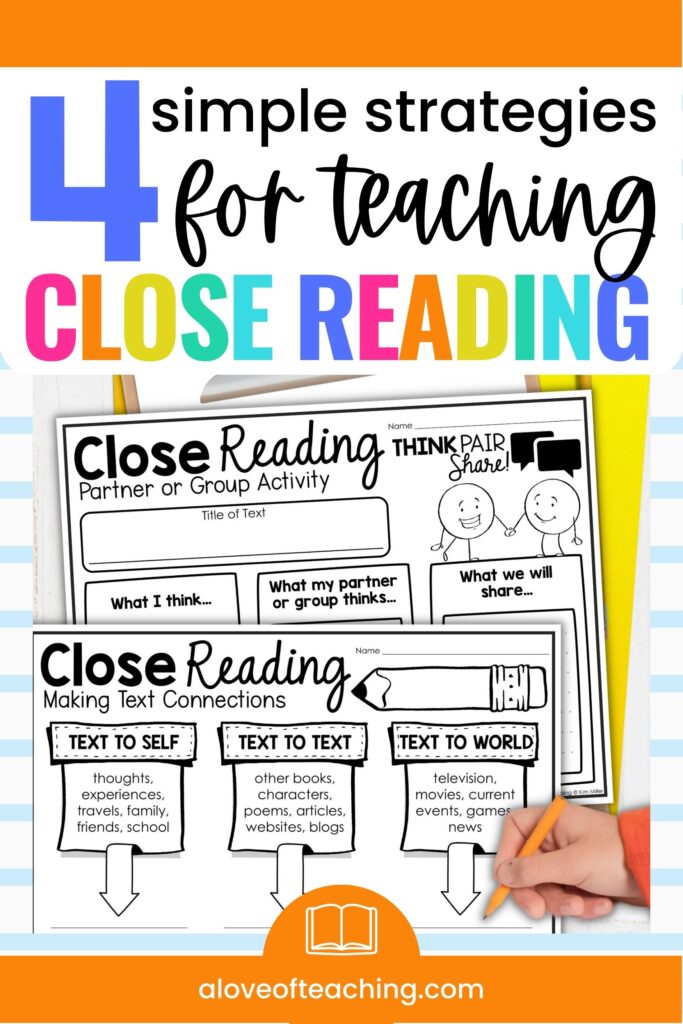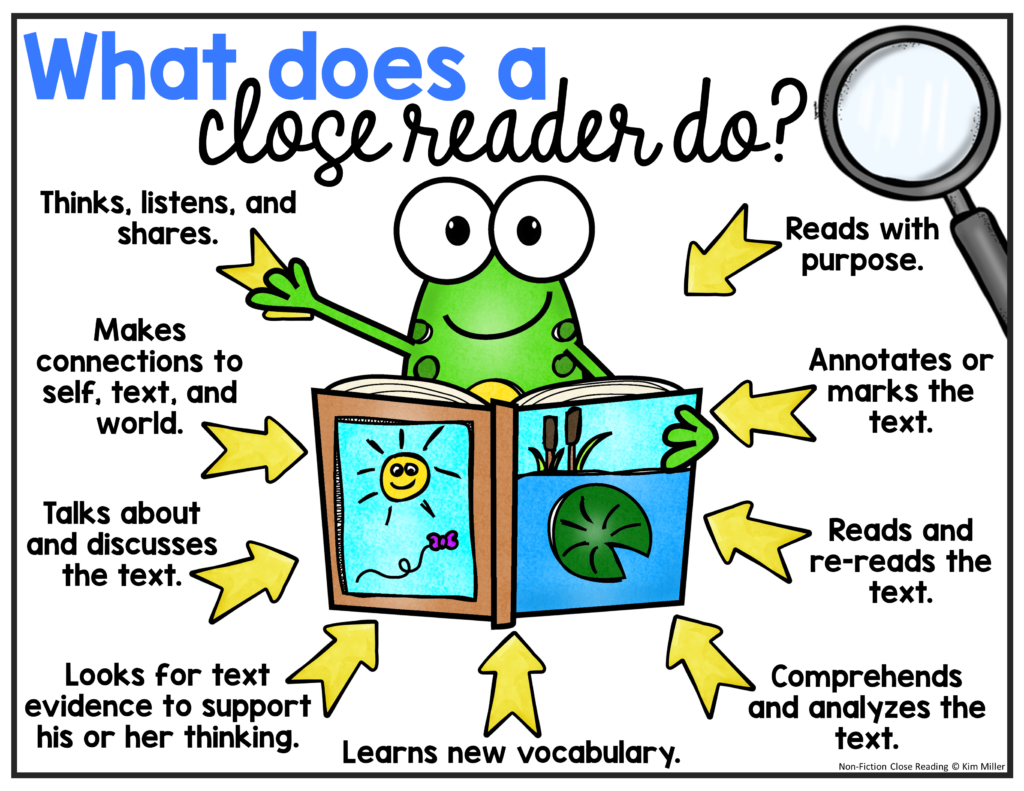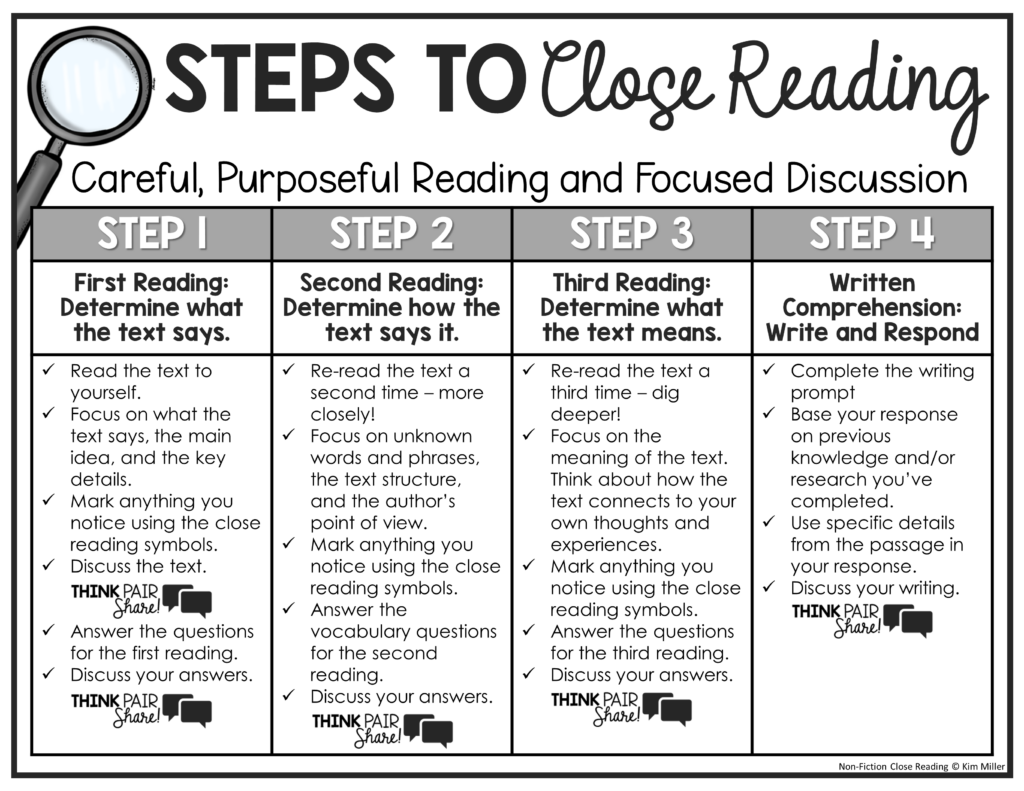4 Simple Strategies for Teaching Close Reading
Are you looking for a strategic and intentional way to teach those important reading comprehension skills and strategies? I used to teach them one at a time. They seemed so disconnected and independent, and I knew my students weren’t getting all they could. Then I found close reading! As I started researching and learning more about this style of reading instruction, I knew I had found a gem. I began using close reading in my classroom and was amazed at my students’ growth and progress.

What is Close Reading?
Close reading is a reading strategy that involves multiple readings of the same text to focus on different reading skills. With each reading, students get a better understanding of the text. With each reading, students are also using higher-level thinking skills as they work on analyzing the text.
I’ve seen close reading set up in different ways. Some teachers present their students with the text three times, others more. I don’t know that there is a magic number for how many times to read the passage. It’s more important to present the text multiple times, each time with a different focus.
Each text reading builds upon the last, allowing students to gain a better understanding of the text. Here’s how I used close reading in my classroom:
- Step 1: First Reading – Determine what the text says.
- Step 2: Second Reading – Determine how the text says it.
- Step 3: Third Reading – Determine what the text means.
- Step 4: Written Comprehension – Write and respond.
Because close reading includes careful, purposeful reading and focused discussions, your students learn how to read and think about what they are reading. The ultimate goal is that they will be able to self-monitor, apply close reading strategies, and read independently with increased comprehension.
A Step-by-Step Approach to Close Reading Strategies
Let’s look at each of the steps for successfully using close reading strategies in your classroom.
Step 1. First Reading – Read and Annotate: Key Ideas and Details
This step is going to be your student’s first introduction to the reading passage. Before your students start reading the passage, be sure to remind them to focus on what the text says. They should be thinking about the main idea, key details, and how the information in the text is related.
I like to hand out the “Mark It Up” annotation cards to my students. This helps them remember the annotation marks they will be using. It helps them to identify unknown words, key details, questions they may have, and connections they can make.
As students are finishing their reading, I ask them to complete the comprehension questions based on the first reading. This allows students to answer the text-dependent questions and cite text evidence to support their answers.
After the first reading, I like to incorporate a partner activity to give students an opportunity to talk about what they are reading with others. I’ve found that a Think, Pair, Share activity works well for this. I use a Think, Pair, Share graphic organizer to help students discuss and take notes on their own.
So often, reading comprehension passages stop here. One reading, answer questions and move on. But there’s still so much more we can do using close reading strategies.
Step 2. Second Reading – Vocabulary: Craft and Structure
The second reading of the passage can be done independently, as a partnered activity, using choral reading, or even as a teacher read-aloud – whatever best fits the skill level of your class.
While students are completing the second reading, I remind them to pay close attention to unknown words and phrases. I want them to focus on vocabulary words that lead to a deeper understanding of the text, the text structure, and the author’s point of view.
Next, it’s time for the Second Reading: Craft and Structure Vocabulary Questions. I want to be sure my students are using text evidence to answer the vocabulary questions from this worksheet. They will identify the meaning of unfamiliar words using text evidence to support their understanding.
Finally, it’s time for them to check for understanding and discuss what new vocabulary they have learned with others. I always like to build in time for students to discuss their learning with their peers.
Step 3. Third Reading – Digging Deeper: Integration of Knowledge
During this third reading, students will be focusing on determining what the text means. Now that students have a general idea of the passage and have a better understanding of the words used, they are ready to dig in using those higher-level thinking skills.
Before this reading, I remind students to focus on the meaning of the text and how the text connects to their thoughts and experiences.
After reading, we work on the third set of reading comprehension questions. These questions guide students to yet an even deeper understanding of the text. I continue to ask students to use text evidence to answer the questions so that they can always make sure their answers are based on the text.
As always, I end this step by allowing students to complete a paired activity to discuss their answers with others. This can be done through a Think, Pair, Share activity or completed together as a class.
Step 4. Write and Respond: Written Comprehension
The final step of the close reading process in my classroom connects reading with writing. This step not only asks students to recall, explain, or analyze information from the text but also to take the time to write about it.
By using a writing prompt, I can get my students to think about what they have read and respond with their own thoughts. Using their previous knowledge and details from the passage, students can show their understanding of the reading.
If we complete one step each day, then Friday (day 5) is reserved for sharing our written responses and discussing with others. It’s a fun and easy way to build in those oral language standards. This is such a great activity because it gets students talking about their ideas and the ideas of others. I like to have my students ask each other questions after listening to the written responses of their classmates.
Using open-ended questions not only gets them thinking about their responses but also recalling information from the passage they have read. It’s also a great way for me to do a quick informal assessment of students’ overall reading comprehension, analysis, and writing skills.
Why I Love Close Reading
The main goal of close reading is to teach our students how to apply a variety of reading strategies and skills to one text to understand it better. The more it is used in the classroom, the more students will begin using this style of deep reading on their own. As the year progresses, you will see students automatically applying close reading to everything they read!
What I love most about close reading is that instead of focusing on a single skill or strategy, students are using all of them in every passage. It helps them see how the different close reading strategies work together to increase reading comprehension. And . . . since you are only using one reading passage a week, there’s a lot less time and planning when it comes to reading lessons and activities. I have even put together my favorite close reading passages into monthly bundles so that you have everything you need for an entire month.
Why settle for one month when you can have the entire year of reading comprehension activities ready to go? This Close Reading Bundle is filled with 45 high-interest, non-fiction reading passages that will help your students practice their close reading strategies and learn to dig deeper into their reading. They are even easy enough to use if you have a substitute teacher.
Pin it!
Be sure to save these close reading strategies to your favorite classroom Pinterest board so you can come back whenever you need close reading ideas for your students.









This Post Has 2 Comments
Your resources are amazing! Do you just sell organizers for close reads?
Hi Kristi,
Thank you!! Most of my reading/ELA resources include graphic organizers. 🙂